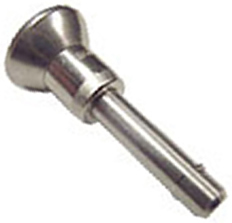
Quick release pins are used extensively in the manufacturing industry. You can typically find them in a variety of manufacturing machines and equipment. They are known as “quick release pins” because they allow you to quickly and easily release the parts with which they are used. There are different types of quick release pins, however, one of which is recessed handle. What is a recessed handle quick release pin exactly, and how does it work?
Overview of Recessed Handle Quick Release Pins
A recessed handle quick release pin is exactly what it sounds like: a quick release pin with a recessed head. All quick release pins have a head. The head is the top part of a quick release pin. To engage a quick release pin — and therefore release the part to which it’s connected — you’ll typically need to grab the head. Recessed handle quick release pins simply have a recessed head. In other words, the head is surrounded by a cone or perimeter of material.
How Recessed Handle Quick Release Pins Work
Recessed handle quick release pins work in the same way as most other button-activated quick release pins. They feature a button that you can press to release the parts to which they are connected. You can grab the head, after which you can press the button. Pressing the button on a quick release pin will release it from the part to which it’s connected. The only difference is that recessed handle quick pins feature this button within a recessed head. You’ll still need to press the button to engage it. With a recessed handle quick release pin, the button is burrowed inside of a recessed and sunken head.
When to Choose a Recessed Handle Quick Release Pin
You should consider using a recessed handle quick release pin to prevent accidental engagement. If you accidentally bump into a quick release pin, you may engage it. Doing so will then release the part to which it’s connected, which can lead to other problems like machinery damage or even bodily injury. A recessed handle quick release pin helps to prevent this from happening by providing a secure environment for the button.
Since the button is located inside of a recessed head, you’ll be less likely to accidentally engage it. Bumping the head, for instance, means that you’ll only touch the cone or perimeter of material surrounding the button; you won’t actually touch the button, nor will you accidentally engage it.
